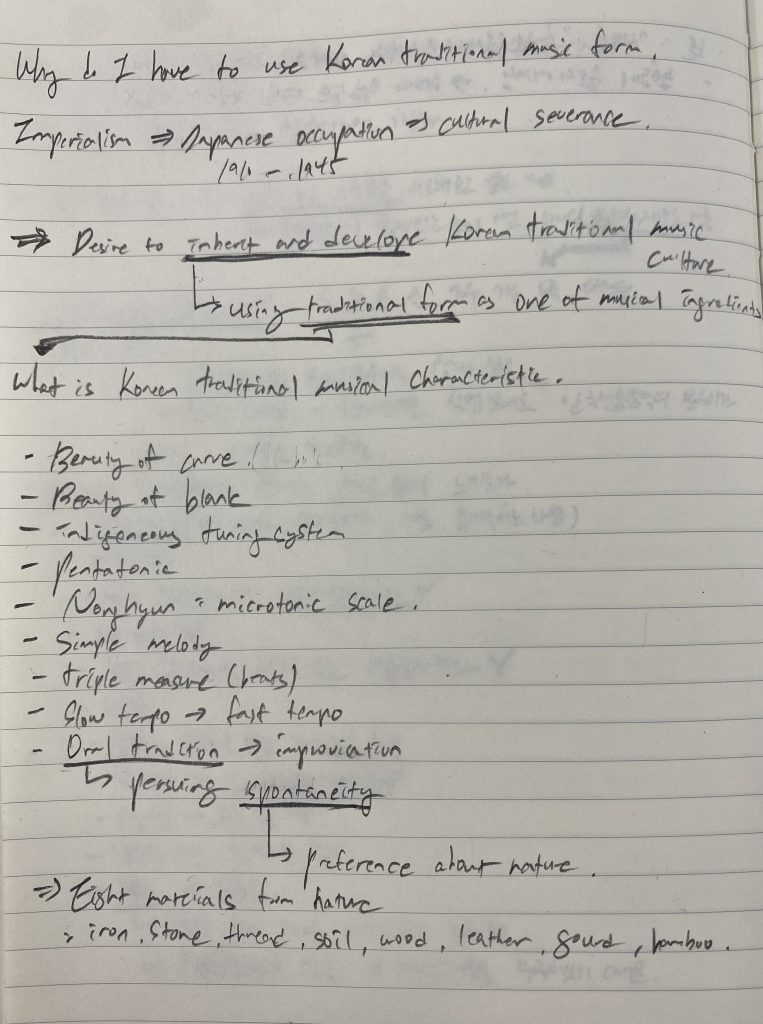
After the tutorial with Gareth, I was inspired to think more deeply about my topic. I started this project with the idea that I wanted to use elements of Korean traditional music as musical materials to inherit or develop the tradition. However, I had many questions such as ‘why do I want to develop this traditional Korean music’, ‘why do I want to use the eight materials to make traditional Korean instruments’, ‘how will I create the form of the song and why do I want to do so’, and ‘what are the characteristics of traditional Korean music’, and I found it difficult to answer them clearly, which led me to this deep dive.
When I looked at some of the musical groups that are currently inheriting traditional Korean music, some of them, such as Ak Dan Gwang Chil, use traditional Korean instruments to create a new kind of music, while others, such as LEENALCHI, create the feel of traditional Korean music without using traditional instruments. This made me think about ‘what makes traditional Korean music feel like traditional Korean music’.
There are many characteristics of Korean traditional music, as I wrote in the note above, but two concepts that run through them all are ‘naturalness’ and ‘beauty of curves’. Korean traditional music uses a lot of differential notes, which can be seen as a way to express the beauty of curves. The beauty of curves can be seen not only in traditional Korean music, but also in various aspects of Korean life, such as traditional clothing and the shape of drywall. In addition, Korea does not use Bipa or Wallgeum instruments, which cannot express microtones, and this feature makes difference from traditional music in China and Japan, which have many similarities with Korean traditional music.
The beauty of the curves is also a concept that belongs to naturalness. In traditional Korean society, there was a great admiration for nature, and straight lines were thought to be distant from nature. Korean ancestors believed that music also came from nature, so they constructed musical instruments using eight natural materials from Bagua, the concept of Yin-Yang and the five elements, and considered music with all eight materials to be the most valuable : Iron, Stone, Thread, Soil, Leather, Wood, Gourd, Bamboo.
Korean traditional music, with the exception of court music, was mostly transmitted orally, which was also based on the idea of naturalness, and it was thought that each human being was different, and that when transmitting music orally, one should not learn by copying the same thing as the teacher, but should make music with their own values or ideology. Therefore, even the same music was always played differently and changed depending on the person. This can also be seen in the tradition of Korean traditional music, where genres such as sanjo and pansori are not only categorised by the title of the song, but also by the name of the original performer, depending on the style of the performer. These features can be seen as spontaneity, but a more detailed classification would be improvisation.
The rhythm of Korean traditional music also has its own characteristics: It mainly uses a three-beat rhythm, progresses from slow to fast tempo, uses a lot of pentatonic scales, and uses a lot of simple single lines. These characteristics are related to the spontaneity, curvaceousness, and improvisation mentioned above, but they are also related to the musical characteristics of China, which has many musical influences.
In conclusion, I will try to create a music that makes use of the spontaneity, beauty of curves, and spontaneity that Korean traditional music has been highly valued for, and I will try to make the music as concise as possible, as it will be 3-5 minutes long, compared to the 30-40 minutes of traditional Korean music.